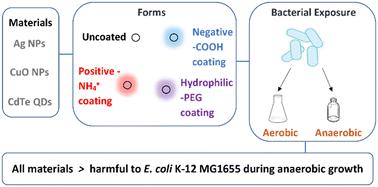当前位置:
X-MOL 学术
›
Environ. Sci.: Nano
›
论文详情
Our official English website, www.x-mol.net, welcomes your
feedback! (Note: you will need to create a separate account there.)
Exposure of Escherichia coli to cadmium telluride quantum dots, silver nanoparticles or cupric oxide nanoparticles during aerobic respiratory versus anaerobic fermentative growth on D-(+)-glucose
Environmental Science: Nano ( IF 5.8 ) Pub Date : 2022-09-07 , DOI: 10.1039/d2en00403h Joanne Vassallo 1 , Rich Boden 1 , Richard D. Handy 1
Environmental Science: Nano ( IF 5.8 ) Pub Date : 2022-09-07 , DOI: 10.1039/d2en00403h Joanne Vassallo 1 , Rich Boden 1 , Richard D. Handy 1
Affiliation

|
The antimicrobial effects of engineered nanomaterials (ENMs) on the bacteria are poorly understood under anoxic conditions. Knowing about these effects can better inform environmental risk assessments. This study investigates the inhibitory effects on growth of silver nanoparticles at 3–6 mg l−1, CuO nanoparticles at 100 mg l−1 or CdTe quantum dots at 3 mg l−1 towards Escherichia coli K-12 MG1655. These exposure concentrations reflect sub-lethal thresholds identified from a screening exposure in 96-well plates. Uncoated or functionalised ENM variants (negative carboxylate, positive ammonium and neutral polyethylene glycol) are investigated, along with bulk materials or metal salts. Bacterial growth is satisfactory, with test reproducibility of 11% coefficient of variation in oxic flasks, and 13% in anoxic serum bottles. Irrespective of the aeration conditions, Ag test materials cause most bacterial growth inhibition, followed by CdTe and CuO test materials. The bulk form of Ag, CuO and CdTe, as well as the Cu, Cd and Te metal salt, cause more growth inhibition under anoxic conditions, compared to oxic conditions (t-test, p < 0.05). However, by surface coating type, there is no clear trend in bacterial growth inhibition, and this also applies across all test materials. Under anoxia, the appearance of millimolar concentrations of fermentation products confirm that the organism can ferment glucose in the presence of ENMs, but with detrimental effects, as there is less energy available to biologically control the presence of metals. Hence overall, the ENMs are more toxic to E. coli under anoxic conditions, suggesting that regulatory tests with microbes that use oxic conditions may underestimate the hazards.
中文翻译:

在有氧呼吸与厌氧发酵生长过程中,大肠杆菌暴露于碲化镉量子点、银纳米颗粒或氧化铜纳米颗粒对 D-(+)-葡萄糖
在缺氧条件下,工程纳米材料 (ENM) 对细菌的抗菌作用知之甚少。了解这些影响可以更好地为环境风险评估提供信息。本研究研究了 3-6 mg l -1的银纳米颗粒、100 mg l -1的 CuO 纳米颗粒或 3 mg l -1的CdTe 量子点对大肠杆菌生长的抑制作用K-12 MG1655。这些暴露浓度反映了从 96 孔板中的筛选暴露中确定的亚致死阈值。研究了未涂层或功能化的 ENM 变体(负羧酸盐、正铵盐和中性聚乙二醇)以及散装材料或金属盐。细菌生长令人满意,在好氧瓶中的变异系数为 11%,在缺氧血清瓶中为 13%。无论曝气条件如何,Ag 测试材料都会导致大多数细菌生长抑制,其次是 CdTe 和 CuO 测试材料。与有氧条件相比,Ag、CuO 和 CdTe 的本体形式以及 Cu、Cd 和 Te 金属盐在缺氧条件下会导致更多的生长抑制 ( t -test, p< 0.05)。然而,根据表面涂层类型,细菌生长抑制没有明显的趋势,这也适用于所有测试材料。在缺氧条件下,毫摩尔浓度的发酵产物的出现证实了有机体可以在 ENM 存在下发酵葡萄糖,但具有不利影响,因为可用于生物控制金属存在的能量较少。因此,总体而言,在缺氧条件下,ENM 对大肠杆菌的毒性更大,这表明对使用有氧条件的微生物进行的监管测试可能低估了危害。
更新日期:2022-09-07
中文翻译:

在有氧呼吸与厌氧发酵生长过程中,大肠杆菌暴露于碲化镉量子点、银纳米颗粒或氧化铜纳米颗粒对 D-(+)-葡萄糖
在缺氧条件下,工程纳米材料 (ENM) 对细菌的抗菌作用知之甚少。了解这些影响可以更好地为环境风险评估提供信息。本研究研究了 3-6 mg l -1的银纳米颗粒、100 mg l -1的 CuO 纳米颗粒或 3 mg l -1的CdTe 量子点对大肠杆菌生长的抑制作用K-12 MG1655。这些暴露浓度反映了从 96 孔板中的筛选暴露中确定的亚致死阈值。研究了未涂层或功能化的 ENM 变体(负羧酸盐、正铵盐和中性聚乙二醇)以及散装材料或金属盐。细菌生长令人满意,在好氧瓶中的变异系数为 11%,在缺氧血清瓶中为 13%。无论曝气条件如何,Ag 测试材料都会导致大多数细菌生长抑制,其次是 CdTe 和 CuO 测试材料。与有氧条件相比,Ag、CuO 和 CdTe 的本体形式以及 Cu、Cd 和 Te 金属盐在缺氧条件下会导致更多的生长抑制 ( t -test, p< 0.05)。然而,根据表面涂层类型,细菌生长抑制没有明显的趋势,这也适用于所有测试材料。在缺氧条件下,毫摩尔浓度的发酵产物的出现证实了有机体可以在 ENM 存在下发酵葡萄糖,但具有不利影响,因为可用于生物控制金属存在的能量较少。因此,总体而言,在缺氧条件下,ENM 对大肠杆菌的毒性更大,这表明对使用有氧条件的微生物进行的监管测试可能低估了危害。











































 京公网安备 11010802027423号
京公网安备 11010802027423号